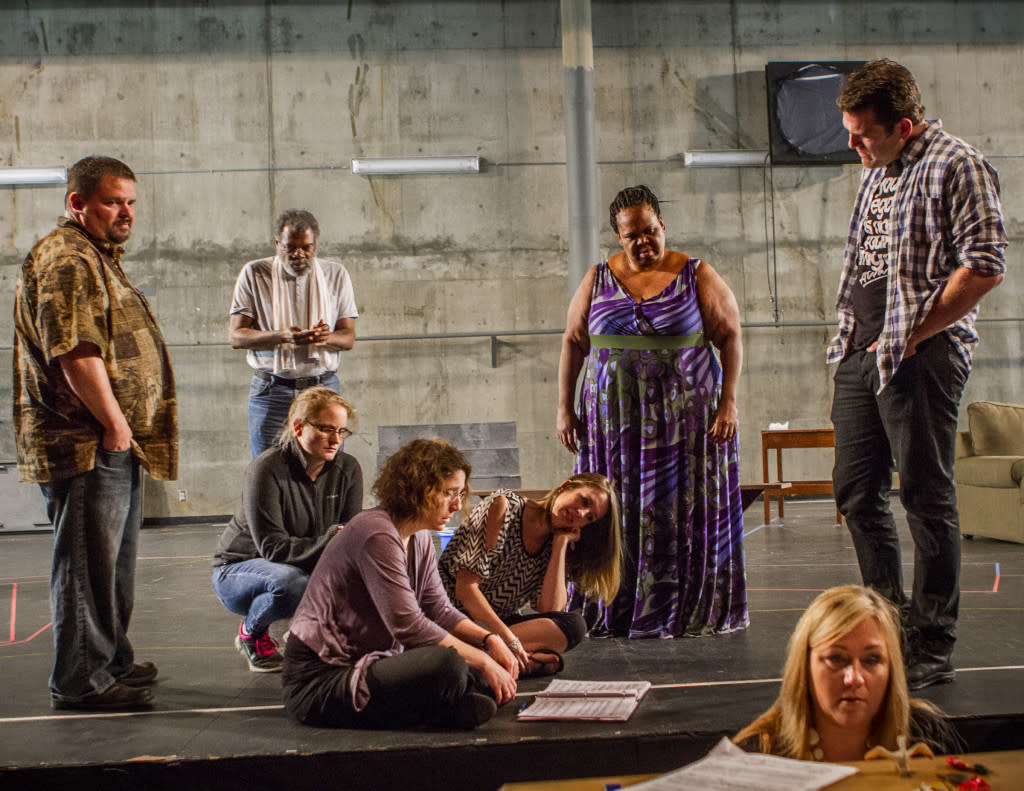‘The Canticle of the Black Madonna’ Wants to Redefine Opera

Left to right: Timothy Galloway (Male Angel), Andre Flynn (Paul), Rachael Marsh (Female Angel), Kristine McIntyre (Director), Lindsey Cafferky (Mara), Gwendolyn Brown (The Black Madonna), Janet Coleman (Piano), Michael Mayes (Adam)
The Canticle of the Black Madonna tells the story of the soldier returning to his home in Louisiana only to see the 2010 Gulf Oil Spill destroy the oyster farm that had been his family’s livelihood for generations. But this isn’t the season opening show at the Portland Opera; it’s an independent world premiere that will be staged at the Newmark Theatre by a small creative team from Southern Oregon on the back of a $75,000 Indiegogo campaign (the total budget is in the neighborhood of $300,000 thanks to generous private donors and some corporate support).
The parallel between the destruction of war and environmental degradation seemed natural to Eugene composer Ethan Gans-Morse and librettist Tiziana DellaRovere, who sought to bring the time-honored operatic form to bear on issues of contemporary social relevance with the hope that Canticle will be part of a new model for opera in today’s world.
“[This show] breaks through the resistance to opera as being decadent, irrelevant, and aristocratic,” says Gans-Morse. “We’ve had a lot of people see it and say, ‘I didn’t realize I liked opera,’ or [opera fans saying] ‘I didn’t realize I liked new music.’”
The two enlisted top talent to bring their vision to fruition. Portland-based but nationally sought-after director Kristine McIntyre’s busy calendar this year has included New Orleans Opera’s La Boheme and Tulsa Opera’s production of Elmer Gantry (and past credits include the New York Met). Baritone Mayes, who plays Adam, recently portrayed Escamillo in Pensacola Opera’s Carmen and the title role in Boston Lyric Opera’s Rigoletto. Gwendolyn Brown, in the role of the Black Madonna, can claim countless celebrated appearances around the world as Maria in Porgy and Bess.
The Canticle of the Black Madonna
Newmark Theatre
Sept 5–6Just as the opera’s protagonist is healed of the emotional wounds of combat, the opera’s creators are using the production as a form of therapy for veterans struggling with PTSD, in part through Anima Mundi Productions, the non-profit arts initiative they founded to produce Canticle.
Veterans’ groups have been involved since the opera’s inception in 2010, supervising the story and helping to facilitate a variety of free services connected to the show, including art therapy workshops and expert lectures on PTSD, and combat veterans appear onstage in uniform during the show. Additional support from environmental groups and ringing endorsements from a workshop performance at the University of Oregon in February 2013 have led to a groundswell of grassroots support for Canticle: the opera’s debut was funded through a successful Indiegogo campaign that raised $75,000 this past June, and the debut run at the Newmark is being produced with support from A Rock or Something Productions, a theater company by and for veterans.
DellaRovere’s libretto coalesces classical operatic archetypes, elements of spirituality drawn from European musical tradition, and Jungian psychology to portray Adam’s path towards healing. The Black Madonna herself fits in as a representation of the motherly love and stewardship within us, although Gans-Morse and DellaRovere make it clear that Canticle is not necessarily connected to Catholicism—in fact, some scholars have argued that the Black Madonna is a much older pre-Christian symbol co-opted by the Catholic church.
Musically, Canticle incorporates different operatic styles for different elements of the show, a tactic meant to create distinct “sound worlds” for separate characters. That said, Gans-Morse is quick to distinguish this compositional strategy from the tradition of pastiche opera. “There are musical threads that tie together; the music becomes deliberately more integrated as the show progresses,” he explains.
Canticle also draws on specific operatic traditions like the brindisi, the drinking song in Italian opera—though not without taking significant liberties. “Our drinking song is [the protagonist] Adam drinking alone, toasting to all the soldiers he lost,” says DellaRovere. “We’ve made it contemporary by inverting it, instead of it being about people coming together.”
The set design by Larry Larson incorporates projections, including all the words, by Oregon Shakespeare Festival video designer Omar Ramos. The costumes come from nationally-renowned, locally based costume designer Sue Bond.
Crowdfunding, intimate venues like the Newmark, and productions that, like Canticle, speak to the needs of the community are all part of a trend towards renewal of the operatic form that Gans-Morse and DellaRovere hope will continue through the 21st century. Or as DellaRovere puts it: “What better medium than opera to deal with issues that are larger than life?”
